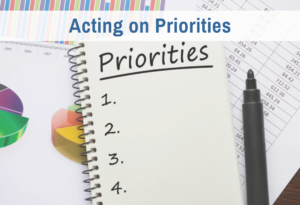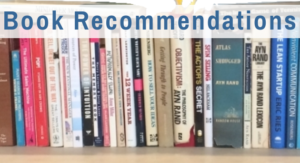In this series on happiness, I have distinguished short-term pleasures and temporary joys from true happiness. To be in a state of true happiness, you need to gain your values every day, week, month, and year. This requires not only that you accept facts of reality, but that your values be consistent with one another, not in conflict.
In the last article, I turned to the question of how you gain control over your own happiness. I argued that you have only indirect control, and that you achieve it through your direct choice to orient to values, not threats. In this article, I will explain this conclusion more thoroughly. It can be understood most clearly in the case of productive work.
Some people view productive work as inherently unpleasant. They think happiness is achieved by a Garden-of-Eden existence in which you need exert no effort, do no work, just loll around. But I dispute that view of happiness and the mistaken understanding of productive work that makes it plausible.
Productive work involves creating values. This is in principle a good thing that should bring joy. Moreover, it’s something you need to do day in and day out as a living organism. You need to create or acquire the values needed to live. The zero-effort view of so-called happiness is in direct contradiction to the needs of life.
On the other hand, since happiness requires the consistent gaining of values, you might be tempted to hypothesize that consistently successful productive work should lead directly to happiness. But it doesn’t. Only value-oriented productive work can support an enduring happiness, and it supports it through the ups and downs of both success and failure.
Why productive work doesn’t necessarily lead to happiness
Productive work doesn’t necessarily lead to happiness because it doesn’t by itself ensure that your values have been integrated.
There are many highly visible, successful producers who are clearly and obviously unhappy. Movies such as Citizen Kane have dramatized this so often it’s become a bromide. In the movies, such misery is usually attributed to the producers’ disastrous personal relationships. That is a symptom of the problem, not the root cause. It is the ongoing conflict between important values that causes these successful producers to suffer.
But difficulty balancing work and personal life is just one way that your values can be unintegrated and put you into perpetual conflict. There are many more mundane cases that are familiar to hard workers everywhere.
People who work hard are often also overcommitted. If they work hard because they’re ambitious, they will keep seeing new things they want to do and will be tempted to add them to the “to do” list. Or if they work hard out of a sense of responsibility, others will see this and do their best to get them on their teams. Then they will assign them more and more work — often more than can be done even by a hard worker.
A state of overcommitment is a state of conflict and suffering. When you are overcommitted, you live in the zero-sum world of all dystopias. Work on one commitment necessarily undercuts another. There is no way to avoid feelings of guilt and frustration except by their ruthless suppression. This is forcing yourself. It feels just as bad when you do it to yourself as when others try to force you.
Even if you aren’t overcommitted, similar problems arise if the goals, timelines, or work standards for your commitments are overly ambitious. Having committed to get something done by a certain time or at a certain standard, you are likely to feel pressure — social pressure, deadline pressure, perfectionism. This is inherently unpleasant.
Some people report that pressure helps them concentrate to work harder. It may do so in the short run, but in the long run, working under pressure fosters a vicious cycle of burnout and procrastination. You procrastinate because you don’t want to experience that pressure. The next time, the pressure needs to build even higher to smash through your resistance. You then work yourself to a point of exhaustion. As soon as you finish, you collapse, unable to work for some time. At first, your exhaustion and need to recover justify delaying starting up work again. But this delay subtly transitions to procrastination as you anticipate the pressure you will work under next time. The cycle repeats.
A burnout cycle is a state of conflict and suffering. When you are in such a vicious cycle, you are in a “rat race” where life is a maze with no exit. All you can hope for are temporary relief stations between the ordeals of effort.
With these models of hard work, it is perhaps understandable why some people give up on it. Having been burned, they refuse to commit to anything beyond the easy routines of daily life. But of course, they don’t accomplish much of anything, either. As a result, there is a dearth of pride, confidence, and joy in their lives. At most, they can hope for a state of contentment.
Their mistake is to think that this kind of ongoing conflict and suffering are inherent in putting significant effort into productive work. It’s not. It is the result of misdirected effort.
The real problem
Many people believe that they control their success by the amount of effort that they expend. They view “hard work” (with the emphasis on “hard”) as the basic means of achieving significant goals.
But this is a distortion. Any given person has a limit to the effort he or she can expend without collapsing in exhaustion. Yes, achievement requires the investment of effort. But beyond a very limited range, getting a larger scale of results requires a different, more creative, more strategic use of your effort, not more effort per se.
This is the most important reason you need to monitor your progress toward any goal. Sure, you need to correct course if the environment changes or new factors come in from the outside. But more than anything, you need to correct course if you are exceeding your capacity for exerting effort.
If you are overcommitted, the solution is not to try to get everything done willy nilly. The solution is to prioritize what is most important, and decommit from what isn’t. You can always do what is most important.
If you are under pressure — which means you are literally operating without enough crow space to think effectively — the solution is to rework the assignment to a chunk that you can fit in your crow and think effectively about. You can always reduce the issue to its essentials, such that you can think effectively about the next part or next step. This is always better than flying blind.
The real problem, and the real reason a lot of people are less productive and less happy than they could be, is that rather than adjust their commitments to match their current capacities, they fight reality by stewing over conclusions such as:
- “I can’t have everything I want.”
- “I’m not good enough to do it all.”
- “I should be able to do this faster.”
- “I don’t have time to take care of myself.”
This is what an orientation toward threats looks like. The focus is on what they can’t do, not what they can. The emotions that get triggered concern the bad things that will happen when they don’t do them. From there, it is a short step to feelings of self-doubt and guilt. If they don’t know how to handle these gut-wrenching emotions, they will likely suppress them, buckle down, and force themselves to move forward willy nilly without ever resolving the underlying conflicts.
This is the kind of tragic mistake that perpetuates suffering for a lot of well-intentioned people who work hard and are trying to achieve something real in their lives.
The value-oriented alternative
The value-oriented alternative starts with holding the context that you are the biggest value at stake here, not the task you are working on.
As part of the self-direction process I teach, I recommend that you break out of a threat orientation by pausing and activating a self-esteem context. Informally I call it “having your own back.” It consists of three parts.
1. Don’t run away — which the fear of the threats can tempt you to do. Instead, face all of the facts, including how you feel, the limits of your capacities right now, and the new information you have just gained about your commitments.
2. Don’t melt down — which the apparent enormity of the threats can tempt you to do. Instead, remember it is your values that are at stake here. It is your life that matters here. It is your happiness that is at stake. That is more important than any threat. Keeping sight of your values is what will give you the courage to deal with the threats, however large.
3. Don’t stab yourself in the back — which will happen if you let your automatized defenses take over. Letting known bad habits kick in will just make the situation worse. Overloading your crow will just make things worse. What you need in this moment is your conscious conclusion about what is in your rational self-interest. You need a chance to think rationally about the issue.
Pausing to “have your own back” takes effort. It can be uncomfortable. But it only takes a couple of minutes, and it helps you regain a value-oriented context upon which to make decisions and solve problems.
In the cases we’ve been discussing (overcommitment and/or overly ambitious goals), activating a self-esteem context sets you up to prioritize on the basis of values, not threats. In the Thinker’s Toolkit and Do What Matters Most, I teach a process called “Decision Cards,” which explains the mechanics of how you do that. (I’ve written up an extended example of the process here.)
As part of making decisions on the basis of the top values at stake, you untangle the conflicts. You figure out what really is in your rational self-interest. When you cleave to the biggest value with a full understanding of all of the ramifications, it is relatively easy to let go of the lesser values that you might not have time for. It is a healthy goodbye rather than a sacrifice. It leaves you in a state of serenity, not self-deprivation.
In fact, every aspect of productive work is improved if performed with a value orientation rather than a threat orientation. If you have a setback or failure, you can focus on what you learned and what your best way forward is. If you get a partial success, you can focus on how far you’ve come and what you learned about how to get the rest of the success. If you need to communicate with members of the team, you ensure they all understand what really matters, and as a result you unleash their creativity rather than constrain them by rules and preconceptions.
I’m painting with a broad brush to get across the point: the need for the value orientation comes up in every aspect of productive work. It smooths the way whenever it is used. It is what ensures that conflicts get resolved, sooner or later. It is what ensures you don’t get stuck in some inward-looking vicious cycle.
The value orientation does not gain you the values that make you happy. Tending your health does that. Productive work does that. Good relationships contribute to that. What the value orientation does is to ensure that your productive work (and every other undertaking) is pursued in a way that is consistent with every other value you hold, such that you win on all fronts as you move through life. And when productive work pays off in significant long-term successes, they trigger a “joy without penalty or guilt.”
This is what I mean when I say that a value orientation is your means of indirect control over your happiness. This is the foundation of the final major point in this series, which we will turn to next: Happiness requires embracing causality.









0 Comments